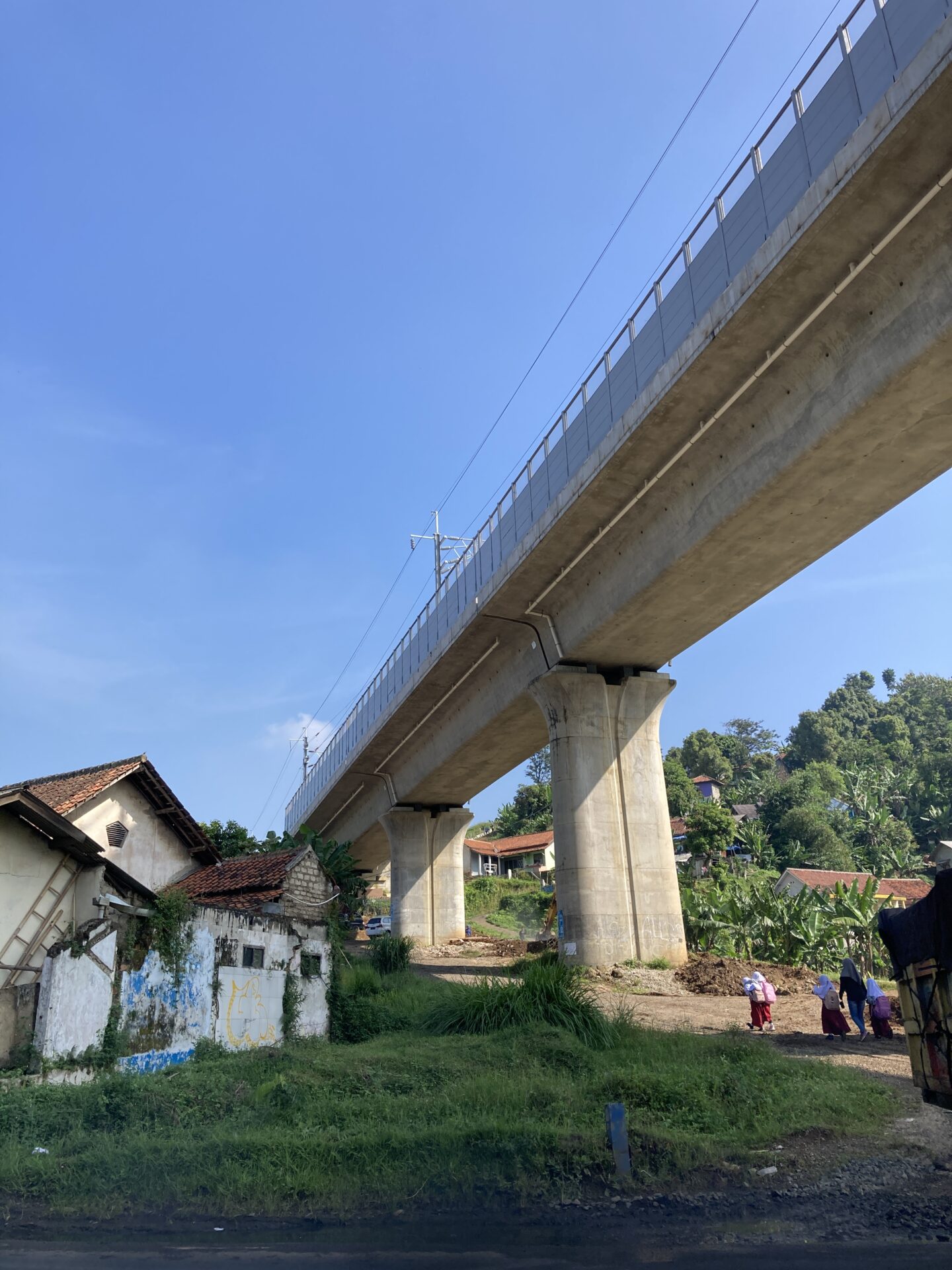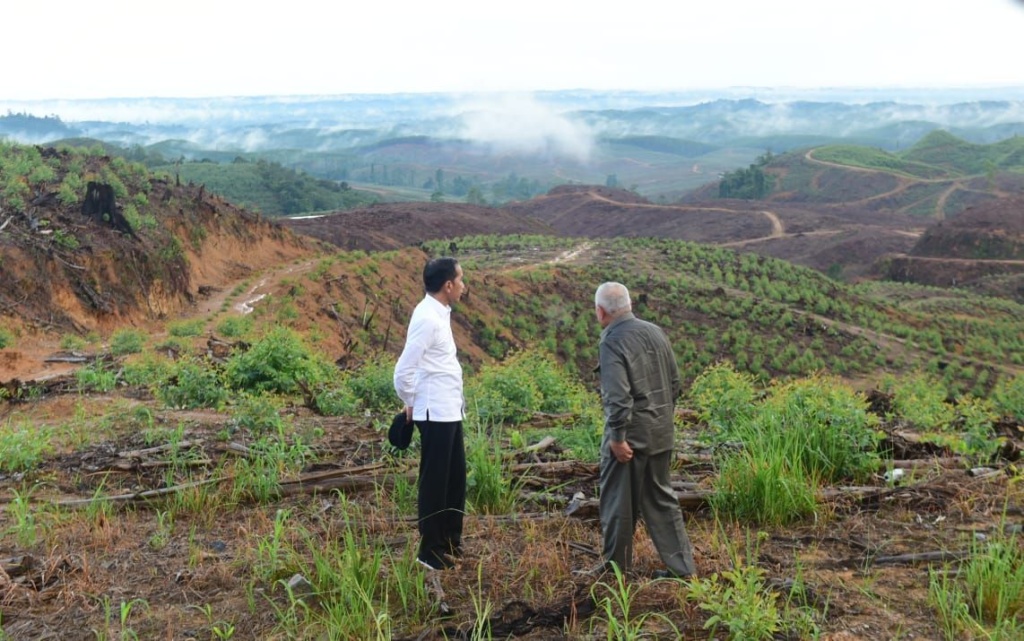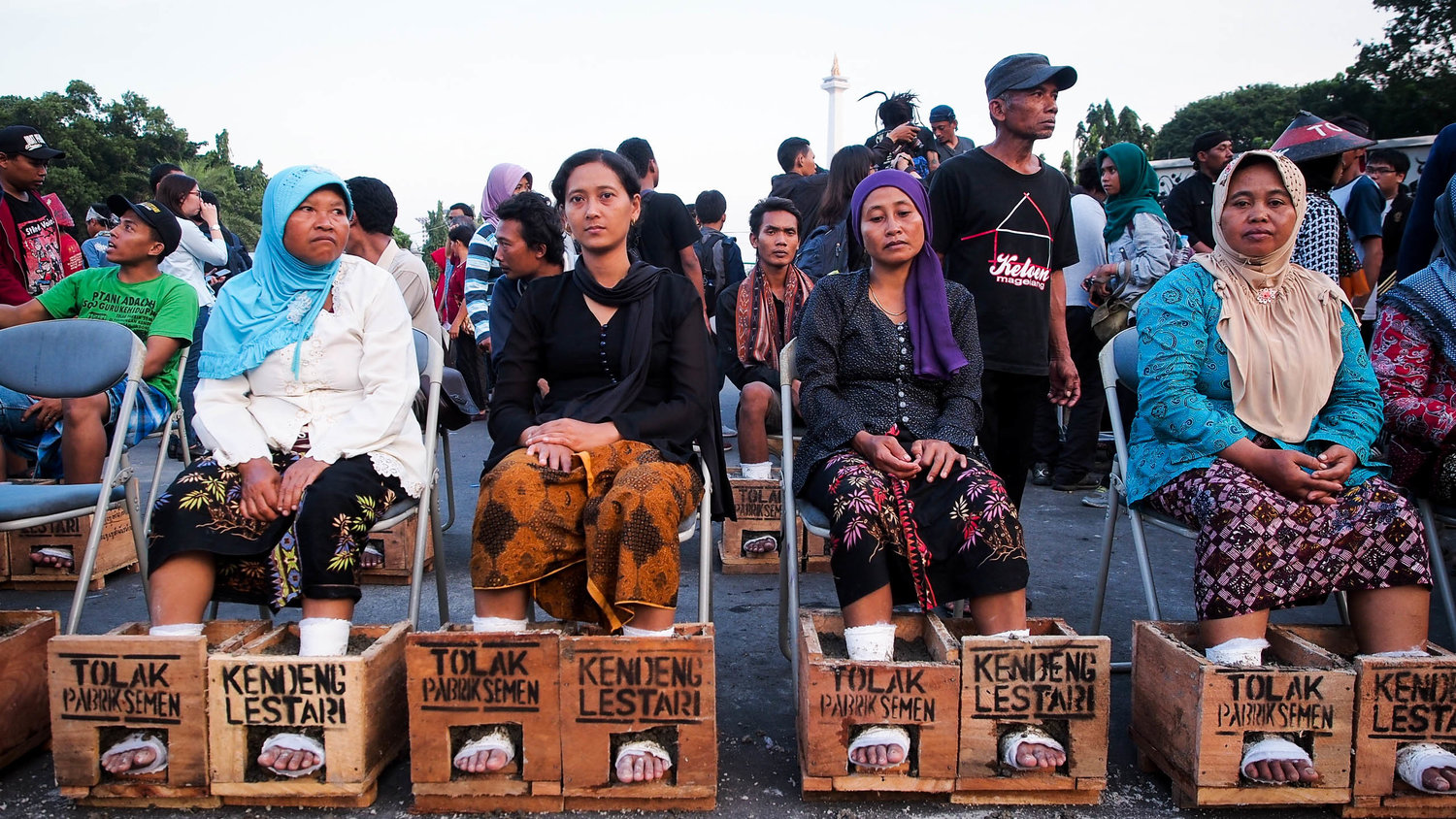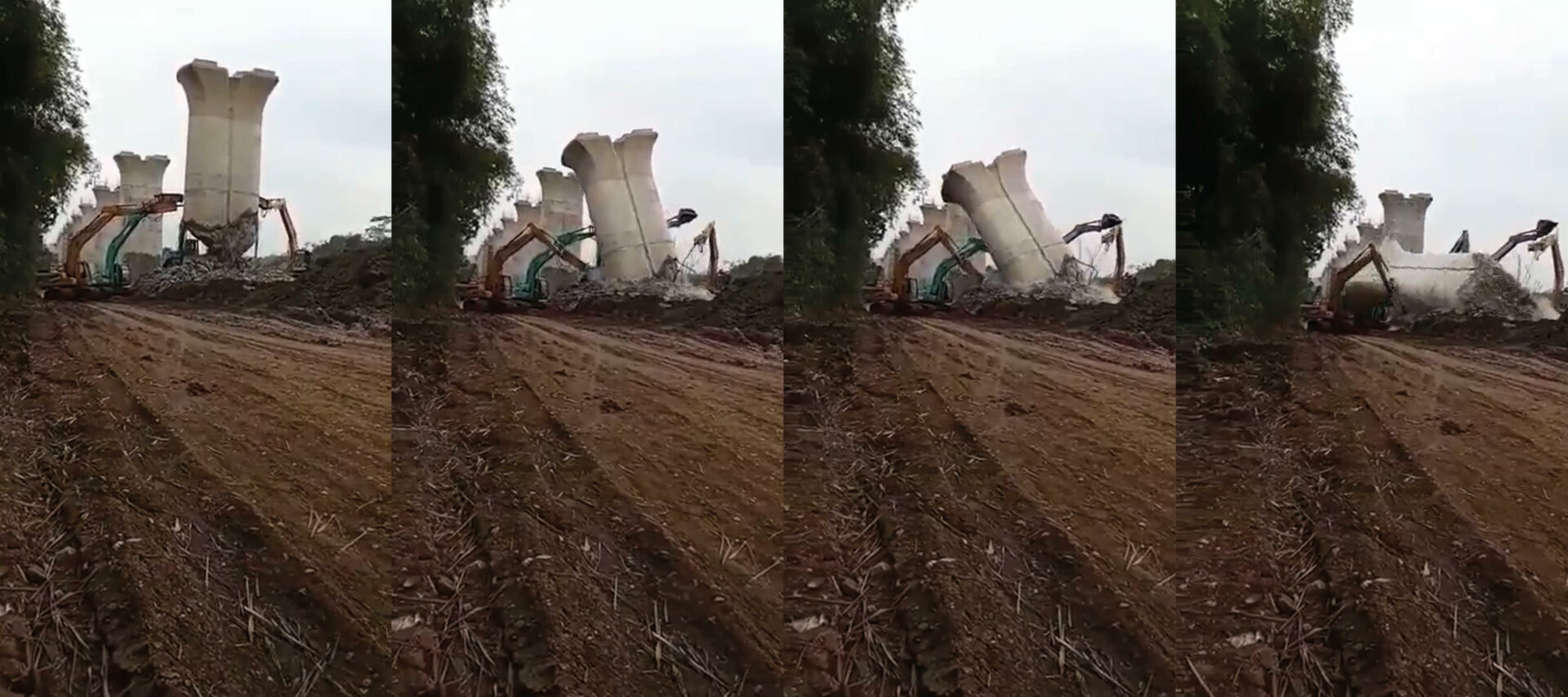To the east of Jakarta, masts of colossal concrete pier columns march through the polluted hinterlands of the industrial area. This spectacle is made up of a whopping five layers of transport infrastructure: city roads, a toll road, an elevated toll road, elevated LRT tracks, and elevated high-speed rail tracks. This concrete jungle in the in-between zone of Greater Jakarta is in perpetual motion, yet completely static — a silent monument to the country’s nation-building projects. The area is part of the Jakarta Metropolitan Area, which houses over 30 million people, around 1.4 million of which commute into the city every day. Uncontrolled urban sprawl has pushed affordable housing farther away from the city centre, requiring large-scale infrastructure to meet the city’s economic needs. But Jakarta has exceeded capacity: it is sinking at a rate of up to 28cm a year under the weight of an exponentially growing population. This is used as justification to relocate the capital city from the island of Java to the island of Kalimantan, the country’s biggest island and home to one of the world’s most extensive tropical rainforests. There, the government plans to build a brand new city dubbed Nusantara, alternatively referred to as Ibu Kota Negara or IKN. While this massive undertaking is a genuine effort to alleviate the existing stresses on Jakarta, it also serves as an ambitious legacy project for ruling parties, whose political ambitions often come at a real human cost, as we shall see later in the article.
As in other modern cities, concrete is central to Indonesia’s infrastructure projects. It is a material with a consistent presence in Indonesian cities. Its ubiquity encompasses not only buildings, but includes roads, bridges, and other forms of national infrastructure. In Jakarta’s goal to catch up to the rest of the world, concrete becomes a tool to attain modernity. To make concrete, three ingredients are needed: cement, water, and an aggregate such as sand. Cement itself is made from clay and limestone, sourced from quarries and processed in factories across the country. The resource-heavy and labour-intensive process of concrete production makes the cement industry a massive contributor of global carbon emissions, contributing to at least 8% of global carbon emissions caused by humans. Even so, these ingredients are only made into a commodity through the hands of workers, making human labour a key component in the making of cement and concrete. It is this key ingredient — human labour — that is routinely exploited within these nation-building projects, which expand even further to devour the labouring body and its environment, putting into question the real value of the nation and its infrastructure.
In Indonesia, cement itself is a major commodity. Indonesia is the fourth largest producer of cement in the world, having produced 74 million tonnes in 2020. Of that, upwards of 29 tonnes are produced by the country’s largest cement company PT Semen Indonesia in factories across the archipelago. Strangely, the supply of cement far outpaces the demand. In fact, Indonesia produces so much cement that it has suffered a crisis of overproduction since 2016. While a post-pandemic economy has slowed production, the projected demand from current mega-projects, such as the new capital city, is expected to help the demand for cement catch up with the supply. No explicit moratorium has been placed on cement production, though the government has slowed down approvals for further cement production.
Regardless of these production counter-measures, Indonesia’s latest concrete megaproject, the Jakarta-Bandung high-speed rail, marches on. It is a joint venture by corporations owned by the Chinese and Indonesian governments. Forming the first phase of China’s Belt and Road Initiative in Indonesia, it is the country’s first high-speed rail project. It is also by far its most ambitious transportation infrastructure project, its concrete piers parading through the Indonesian countryside. Running right alongside it is the Sheikh Mohammed bin Zayed Skyway, the highest elevated double-decker expressway in Southeast Asia. At 33.6km long, its suspended concrete roads visibly undulate and soar above an existing toll road. The expressway was constructed to alleviate the area’s infamous heavy traffic and to grant long-distance inter-city travellers direct access to Jakarta’s city centre. Both China and the UAE have made major investments in Indonesia’s infrastructure, from China’s Belt and Road Initiative to the UAE’s Look East policy. In 2020, the UAE and Indonesia signed 16 memorandums of understanding, while Indonesia’s coordinating Minister of Maritime and Investment Affairs, Luhut Pandjaitan, publicly supported the Belt and Road Initiative and made calls for public support of China-Indonesia cooperation. These highly-publicised lateral relations form the bedrock of bigger infrastructure deals.
At the centre of these infrastructure deals sits the new capital city Nusantara. It is sold to the world as a “smart and sustainable forest city”, conveniently accommodating every climate buzzword and making use of corporate-speak to attract the right investors. Part of Indonesia’s ambitious plan to become “a developed country by 2045”, Nusantara promises to be a glittery green city, divided into eight attractive-sounding clusters: six to focus on green and sustainable industries, and the other two on education and Industry 4.0 goals. Such a challenging project would rightly require a large sum of money, a subject of much contention considering that 20% of the state budget will be used to fund it. With the project already running over budget, the government is scrambling to find sources of funding. In comes the impressive line of international investors, most notably the UAE, whose emir has been appointed as Chairman of the New Capital Development Steering Committee — a group responsible for overseeing the construction of the new capital city. The committee includes two other crucial world figures: Masayoshi Son of SoftBank and former UK Prime Minister Tony Blair. In order to attract more foreign investors, Indonesia offers ease of imports and exports and 30-year tax breaks for investments in infrastructure, among other things. These are, of course, very attractive deals, as Indonesia is a major producer of key raw materials, from nickel to palm oil.
Despite the government’s grand assurances of the project’s sustainability, this scale of extraction will have direct negative impacts on both the forests of Kalimantan and the communities living there. This includes the Indigenous Balik residents of East Kalimantan, who have objected to the expropriation of their land and resources as construction commences for the new capital city. Their daily lives are disturbed by the sounds of heavy machinery, their rivers dammed, and their farms destroyed. Balik residents feel that the government’s heroic notions of nation-building have come at their expense. Reports clearly show that the project will have a negative impact, citing, for example, that over 256,000 hectares of rainforest will need to be cut down for the construction of Nusantara, a recurring theme also reported in other parts of the country.
In Central Java, the building of new cement factories is causing serious damage to forests and water sources, affecting local communities such as the Indigenous Sedulur Sikep of Kendeng in Central Java. The Sedulur Sikep are historically known to implement anti-imperialism as a way of life, resisting regulations and bureaucracy even during Dutch colonial rule. Now, their way of life is threatened by their own government, which is allowing corporations like PT Semen Indonesia to build factories on their ancestral land. These factories would pollute streams and destroy forests which the Sedulur Sikep depend on. In 2016, a group of women activists known as the Kartini Kendeng staged a series of demonstrations by casting their feet in concrete and sitting in front of government buildings for a number of days. The action garnered national media attention and coverage by established national networks. Despite this, they have seen limited results. In January 2022, President Joko Widodo issued a statement claiming to have cancelled over 2000 permits issued to mining companies in Kendeng; whether or not that has had any real impact on the ground remains unclear. Even so, environmental rights groups such as the Jaringan Masyarakat Peduli Pegunungan Kendeng (People’s Care Network for Kendeng Mountains or JM-PPK) continue to report protest activity happening across Java. As recently as May 2023, the Sedulur Sikep issued a statement of protest against German cement company HeidelbergCement AG, demanding an end to the construction of factories on their ancestral land.
The Kartini Kendeng has done something remarkable. By using concrete — the very material against which they are protesting — as a symbol of their protest, they turn it into a material of struggle, momentarily severing its ties to infrastructure. The women of Karitini Kendeng have transformed concrete from a static material of state dominance into one of civil defiance. This phenomenon reflects James O’Connor’s second contradiction of capitalism, in which the forces and relations of production degrade the conditions of production — in this case, nature and human labour. In the same way that human labour combines cement, water, and aggregate to construct structures, human labour has the capacity to defy said structures through the intervention of the labouring body.
Human labour is a crucial ingredient of concrete, but is often ignored or outright violated. The insignificance and disposability of the labouring body is a deeply-ingrained idea in Indonesia and has made its way into popular culture and superstitions. The concept of tumbal proyek or a “project sacrifice” is a widely-believed urban legend in which a human sacrifice — usually one of the workers — must be made in order for any construction project to be successful. Such superstition is not unique to Indonesia, as various reports among other Asian cultures have recorded similar stories, notably the hitobashira (human pillar) in feudal Japan. The concept of human sacrifice is a grim metaphor for the human cost of Indonesia’s infrastructure, modernity, and the full bellies of beneficiaries.
The disregard for the well-being of workers in Indonesia is well-documented. A viral video circulated on Indonesian Twitter in December 2021, showing one of the giant concrete piers of the Jakarta-Bandung high-speed rail being demolished haphazardly before collapsing on one of the excavators. It was reported that there was a misalignment in a section of the built piers, and that it needed to be reworked. On Twitter, the video sparked heated conversation over safety regulations and the general competency of the contractors responsible. Considering the money and labour involved, the public questioned how an avoidable miscalculation in a high-profile infrastructure project could happen in the first place.
Through this, we see concrete monuments erected only to be demolished soon after, a poetic snapshot of Indonesia’s relationship with infrastructure and its nation-building missions. The video is a glaring display of incompetence and public endangerment at a national level, and an absurd reflection of the nature of the country’s wavering efforts at greatness. Along the way, it is the bodies, labour, and resources of the marginalised that are expended and exploited.
In November 2021, the Minister of Environment and Forestry Siti Nurbaya Bakar attracted a whirlwind of controversy after tweeting: “Massive development under President Jokowi must not stop in the name of carbon emissions or in the name of deforestation.” Such an explicitly anti-environment statement coming from the minister responsible for environmental affairs in one of the most biodiverse countries in the world is, unfortunately, emblematic of the current administration’s priorities. The road to power is cyclical and undulating, and concrete, again and again, becomes a material motif that embellishes the ragged tapestry of Indonesia’s infrastructure.
And so infrastructure lives and dies. It lives with the presidents and the investors of the globe, and it dies with the people and the labourers of the village In Indonesia, the problems that are rapidly eating away its cities and its inhabitants are met with a depressingly comical line of thinking: our capital is sinking, so let’s build a new one. This venture for a new capital city still very much relies on extractive practices with regard to both labour and resources. Only time will tell if Nusantara will truly bring Indonesia to so-called modernity, or if it will remain a politician’s pipe dream. For now, though, Jakarta remains the core of Indonesian infrastructure development, cement factories remain a leading contributor to both modernity and marginalisation, and concrete remains the tool for both nation-building and civil defiance. In Indonesia, to progress is to build, to build is to speak, and the language is concrete.




